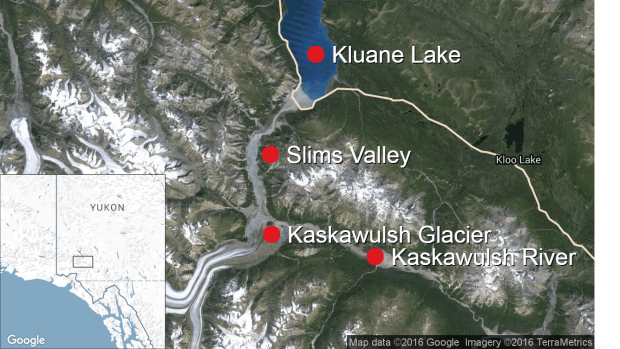Looking up the Slims River Valley, from the south end of Kluane Lake. The river used to flow down the valley from the Kaskawulsh glacier. (Sue Thomas)
“What folks have noticed this spring is that it’s essentially dried up,” said Jeff Bond of the Yukon Geological Survey.
“That’s the first time that’s happened, as far as we know, in the last 350 years.”
What’s happened is some basic glacier hydrology, Bond says — essentially, the Kaskawulsh Glacier has retreated to the point where its melt water is now going in a completely different direction, away from the Slims Valley.

Melt water from the Kaskawulsh glacier now flows down the Kaskawulsh River toward the Pacific, instead of northward to the Bering Sea via Kluane Lake. (CBC)
Instead of flowing north 19 kilometres from the glacier’s toe into Kluane Lake (and ultimately, the Bering Sea), that melt water is now draining eastward via the Kaskawulsh River towards the Pacific Ocean off the Alaska panhandle.
It’s a reminder that glacier-caused change is not always glacial-paced. Last year, the Slims River was still a potentially dangerous waterway, now the area is more prone to dust storms.
“It’s certainly not unusual to see rapid drainage changes in and around these glaciers. It’s a common situation,” Bond said.
“Until vegetation really starts to stabilize that floodplain, it’s going to be a dusty place, I’d imagine … It will be a really interesting study to see how that floodplain evolves in the next ten years or so.”
Kluane Lake water level expected to drop
It’s possible the Slims River was only ever just a temporary variance in the landscape — a 300-odd year hydrological whim.
‘It’s certainly not unusual to see rapid drainage changes in and around these glaciers. It’s a common situation,’ said Jeff Bond of the Yukon Geological Survey. (Vic Istchenko/CBC)
Scientists say it only began flowing around the year 1700, when the so-called “Little Ice Age” caused the Kaskawulsh glacier to advance, and then divert most of its melt water from the Kaskawulsh River to the Slims Valley.
As a result, Kluane Lake grew.
Now, with the Slims River gone, hydrologists are expecting the lake level to drop.
“How much that lowers kind of depends on the outlet, the depth of the water at the outlet right now. I’m predicting it could be at least a meter,” Bond said.
With files from Vic Istchenko










